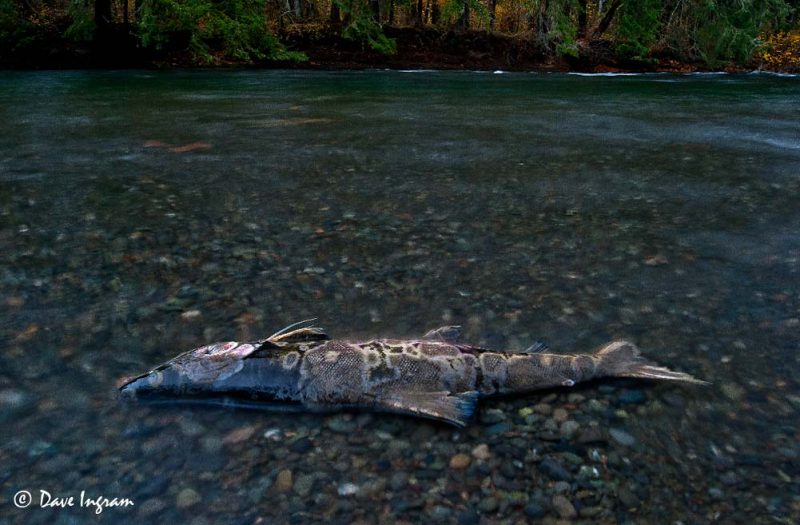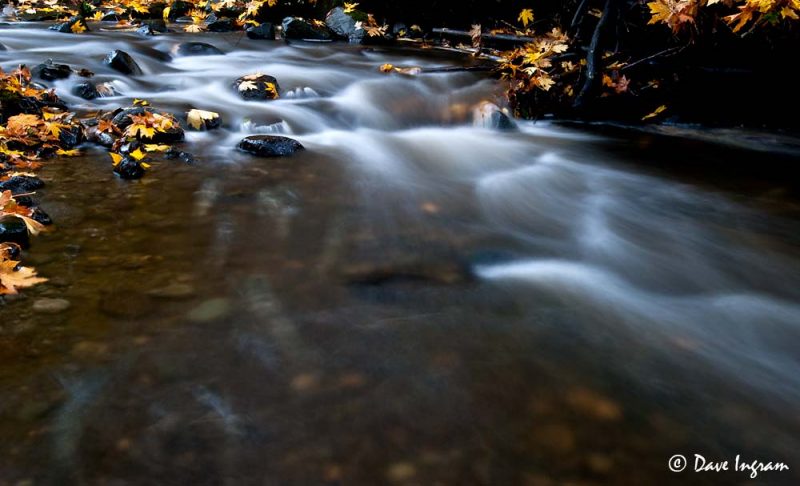I’ve been experimenting with long exposures and photographing moving water (and chum salmon) down at the Puntledge. I don’t have the technique quite right yet and really need to get some neutral density filters so that I can get longer shutter speeds. It has been fun trying different things out and it’s forcing me to use my tripod (which I should be doing more often anyway)!
With my current set up, I’m finding that I have to shoot at my smallest aperture (f22) and 100 ISO to get any sort of long exposure which will create that milky white effect in moving water. Unfortunately, that leaves little room for getting creative with depth of field—wider apertures result in a faster (relatively speaking) shutter speed and less of a milky effect. Fortunately the days have been dark and dismal, otherwise it would be even more difficult to get a slow enough shutter speed.

ISO 100, f/10, 0.5 sec
I wanted to duplicate an image that I created earlier in the week with a salmon on the banks of the Puntledge River and fall colours on the far side of the river. Water levels have risen quite a bit and the location I used previously was no longer above water. I did find a fairly fresh chum salmon (Oncorhynchus keta) on an open gravel bar which made for an interesting photograph.

ISO 100, f/22, 0.8 sec
Of course, dead salmon make for cooperative subjects. Capturing live, spawning salmon is a different story. The problem is balancing the long exposure to get a nice effect on the water while at the same time using a fast enough shutter to capture the moving fish well. I found a place on a side channel where chum were staging up to swim up over a set of stones and tried a number of different exposures.
With my first set of exposures I increased the ISO to 400 to get a little more flexibility in terms of aperture and bit of a faster shutter speed to “freeze” the fish. The light was really failing at this point in the day (and it was starting to rain) which might have helped to produce more aperture/shutter speed combinations.

ISO 400, f/5.0, 0.5 sec
Having got a couple of good images, I thought that I’d try going as slow as possible and see what kind of image that would create. I liked the “ghostly” effect of the fish with the slower exposure—you can tell that there’s something in the water but it’s not easily identifiable.

ISO 100, f/18, 10.0 sec
I think this image tells a story, foreshadowing the eventual fate of the salmon, as well as the important role that they’ll continue to play in the stream ecosystem. When the salmon carcasses are long gone, their “spirits” will remain as their nutrients are passed on to other organisms.
Looking at the other images, there seems to be quite a bit of variability in how clear the fish are (the image above was the best of the set of slow exposure images). A lot depended on whether the fish were moving or staying more or less in place. Longer exposures (I tried several at f/22 and 10 to 15 sec) resulted in the fish being so blurred that they looked like ripples in the water. I didn’t get any in the 1-5 second range and I’m wondering if that shutter speed might have been more effective.
The chum salmon run is in full force on the Puntledge River and there are plenty of fish (both alive and dead). I’m looking forward to when the water levels drop and more dead fish are revealed—they’re always fascinating to photograph!